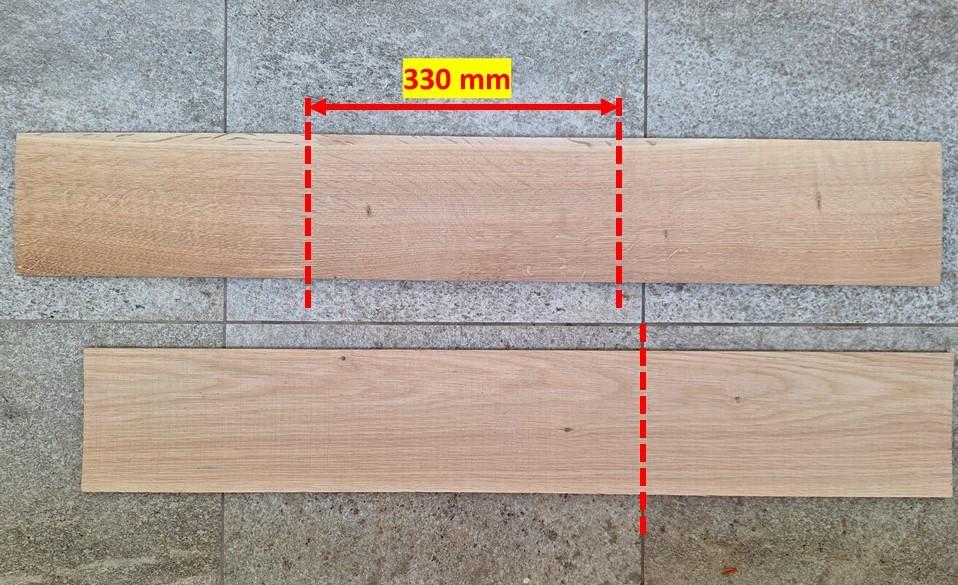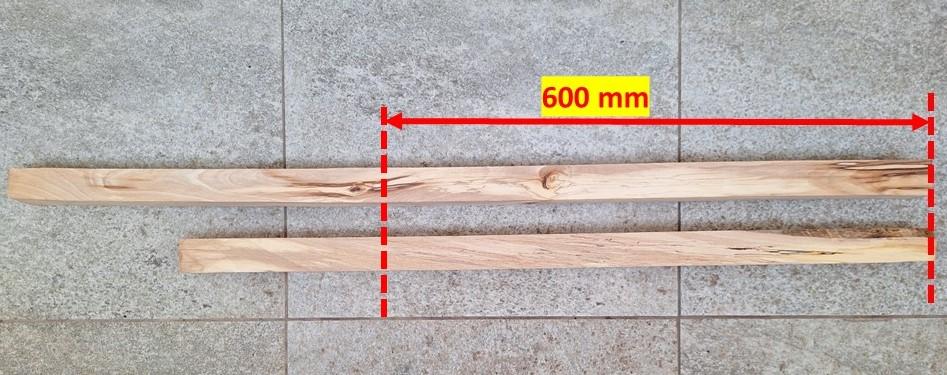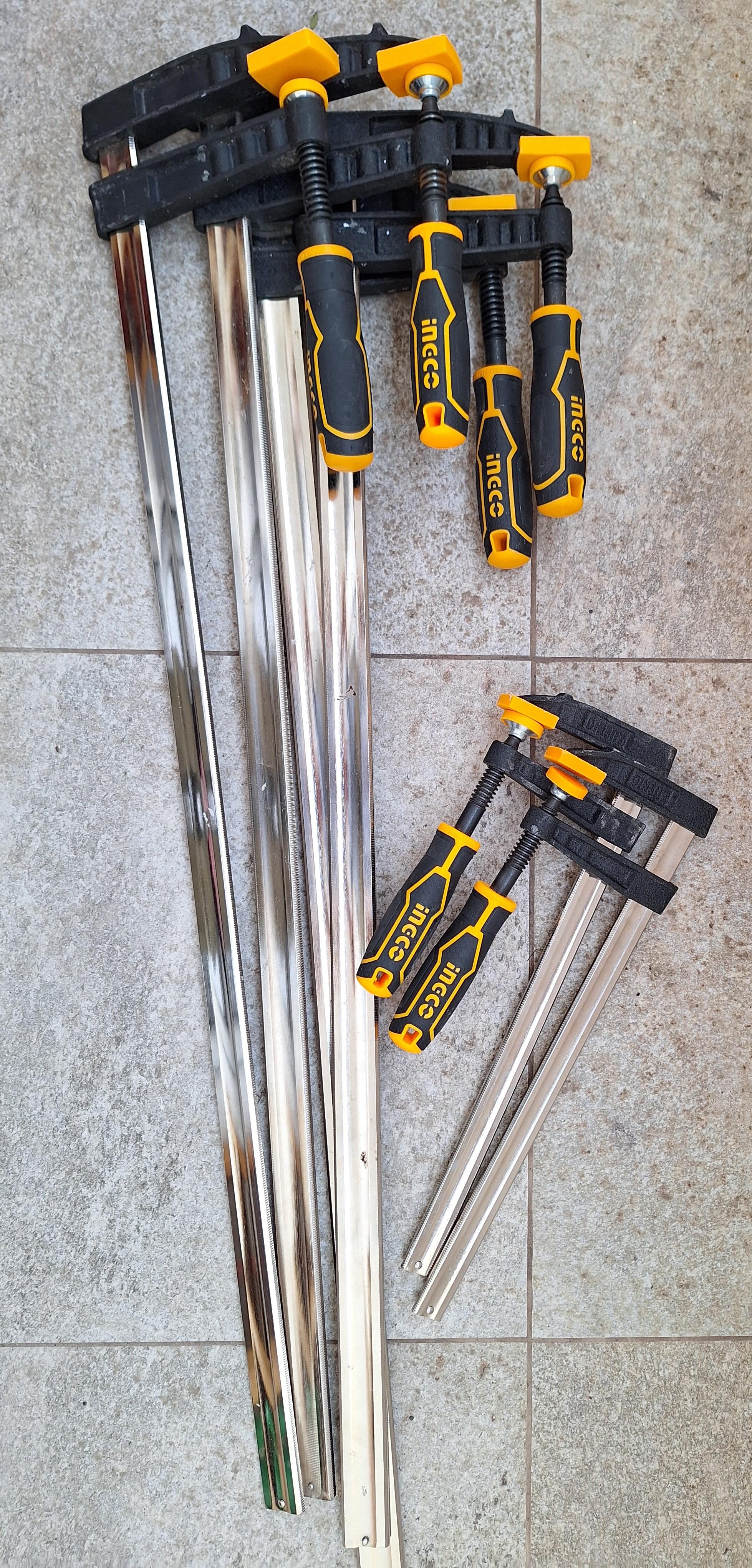Oak/Beech Wooden Pulling Car for 2 Kids With Steering
by davidosukenik in Living > Kids
1838 Views, 16 Favorites, 0 Comments
Oak/Beech Wooden Pulling Car for 2 Kids With Steering


Our 2 sons (2.5 and 1.5 years old) always think about what they could try, climb up on and best - to drive on. After some toys that were a bit weak for their usage and destroyed this way, I thought to make them proper, durable vehicle which they could drive around indoors, and which would hold up to their usage. This project describes how I made a durable vehicle from hardwoods - oak and beech, where 2 kids can sit on behind each other and which can be steered by the child sitting in the front.
Supplies




Material:
- prisms - beech - 37 x 37 x 1000 mm – 4x
- thin boards - oak - 150 x 8 x 1000 mm – 2x
- board - oak - 150 x 150 x 18 mm – 1x
- beech stick Ø15 mm x 10 mm - 1x
- wheels with bearings - 145 x 30 mm with 8mm bore - 4x
- screws M8 x 90 with shank - 4x
- lock nuts M8 – 4x
- washers M8 - 16x
- washers stainsless M14 - 2x
- screw M5 x 45 - 1x
- nut M5 - 1x
- washers M5 - 2x
- eye-bolt M6 x 100 - 1x
- washer M6 - 2x
- nut M6 - 2x
- screw M5 x 60 - 2x
- wood screw 5x100 mm - 4x
- wood screw 4x60 mm - 16x
- steel rod Ø14 mm x 250 mm
- carabiner
- rope - 2 meters
- varnish base and top
- Titebond glue
- silicone spray
- silicone corner protectors
Tools:
- Ø3, Ø4, Ø5, Ø6, Ø8 drill bits
- Ø15 mm wood drill bit
- rounding router bit
- clamps - 4x 300 mm, 4x 800 mm
Machines:
- table saw
- scroll saw
- drill with stand
- router
- Dremel
- sander
- planer (recommended)
A word towards the supplies:
The oak woods were bought from local company making semi-finished products for making oak windows.
The beech long prisms come from a different company making handles for shovels, axes, etc. as a material which had some faults and was discarded.
The wheels were found on a site selling used stuff, but in new condition, for 2 € per wheel.
The fasteners, drill bits, etc. were mostly bought in a nearby good hobby market.
Cutting the Material and Gluing




.jpg)
The build begins by creating the base part of the whole vehicle and that is the base platform where the passengers sit and to this part all other components are mounted.
The base platform is made of 4 segments of the thin oak boards glued together with 2 parallel beech prisms to support the weight. The prisms are cut to length of 600 mm and the oak bards to segments of around 330 mm (1 long board cut to 3 identical segments + 1 more segment from the next board).
The gluing is done by 1 segment at a time - first segment glued to 2 prisms, then 2nd segment glued to 1st and prisms, and so on, keeping eye on the paralellity of the 2 prisms and perpendicularity of the segments edges to the prisms edges (due to limited number of clamps). Titebond III glue was used since it's relly firm and I have good experience with it from the past
After the gluing, the whole part can be formetted on the table saw to nice rectangle with dimensions 600 x 315 mm according to the attached drawing.
In the next substep, we create a "supporting plate" intended as a support for the plain bearings / washers for the turning of the front axle and for better fixation and stiffness of the steering column. The support plate is made by cutting the beech prism to 3 pieces each 130 mm long and gluing them together (with the help of another 4 prisms claming the piece so it is flat), forming final dimensions of 130 x 111 mm.
We can continue with creating the steering column, which is composed of 4 basic beech prisms planed, glued and planed again to a piece with section of 68x68 mm and cut to exact length of 87 mm. I had this piece prepared already from other project, when creating legs for a bed.
When we are already dealing with the steering parts, we can prepare a piece for transfering the steering torque from the steering wheel - this is a small prismatic part made from the standard prisms of 37x37 mm section cut to a length of 46 mm. The steering wheel is then cut from an oak piece thick 18 mm. Different techniques can be utilized to create this circular part, I used a router but it was not very pleasant and dangerous :( (maybe scrollsaw would be easier but would require more precision).
We also need to cut about 10 mm long cylinder from the round Ø15 mmbeech stick.
And finally we can cut the the front and rear axle parts. From our standard prisms we cut 2 prisms of 285 mm length and 4 small prisms with the length of 45 mm. And we are done.
Drilling the Holes

We are done with the cutting (mostly), next up is drilling the holes. For the bores to be perpendicular to the wood surface a drill stand for hand drill is of extreme use (if you don't have proper vertical drill).
Starting from the last cut pieces - the 4 small prisms 45 mm long for the front and rear axle wheels - we drill Ø8 mm hole through the whole material. Remember that the position of the hole differs on front axle vs. the rear axle due to the front axle having 2 washers for steering - check the drawing. On these parts, we make 2 Ø4 mm holes through the whole material for rigidly bonding with the long axle part and countersink them. Right away we make the holes on the same positions but with Ø2.5 mm drill bit to the long axle parts.
Next we take the steering column, mark its centre on the bottom and make 4 holes around its center with diameter of 3 mm, the depth will be about 50 mm and they should be 40 mm apart.
On the supporting plate part, we again mark the centre (crossing of the diagonals) and drill the same 4 holes with Ø4 mm drill bit and make countersinks.
On the steering wheel torque transfering part, we create 4 holes Ø4 mm again around its central axis, while the holes should be 25 mm apart. In the same distances, we make holes of Ø2 mm to the circular steering wheel part, only some 10 mm into depth.
We can move to drilling with Ø15 mm drill bit, with which we drill a hole to the centre of the front axle, but leave a bit of material on the bottom of the hole. With this drill bit, drill all through the steering column in the central axis, as well as the small prism for trasfering steering torque. Again drill a hole in the supporting plate centre and also mark and drill a hole in the main platform part.
Also a shallow hole, 5 mm into depth Ø15 mm is drilled to the center of the steering wheel from the top side. Here the small cylinder from beech stick will be glued.
Rounding the Edges
All potentially harmful edges - steering wheel parts, steering column, base platform top edges - can be now rounded on a router.
Making the Steering Rod

.jpg)
We switch from woodworking to working with metal for a moment - the steering rod needs to be cut to a length of 220 mm from Ø14 mm stock steel rod. This is carried out with a Dremel tool in my case. The edges of the rod can be ground a bit and deburred. Using this steering rod the turning of the front axle will be realized. Further we drill 2 holes in the positions according to the drawing - Ø5 mm and Ø6 mm. Keep an eye on the holes being parallel to each other - entering and exiting the rod in the same longitudinal plane. This way the steering wheel torque transfering block and the front axle will be nice and parallel.
Pre-Assembly


Now is the time to start putting some of the components together. We can begin by gluing and screwing together small wheel prisms to the longer prisms of the axles. I thought this will be pretty stressed part in operation that's why I put in glue and wood screws also.
In the next step we can screw together small torque transferring prism to the steering wheel with 4 wood screws 4x60 mm, also with addition of glue.
Finally the supporting plate, main platform and steering column are screwed together with 4 bigger screws 5x100 mm with layers of glue in between these parts. Thus forming a stiff area, due to its likely that the kids will be stressing this area by pulling the steering wheel with higher force.
Sanding and Finishing


All parts are sanded with excentric sander or complicated areas by hand in about 3 steps - 80, 120, 200 grit.
If desired, we can paint the vehicle with some symbols to make it more interesting for the children, like horn symbol in the centre of the steering wheel, arrow showing the direction of drive, exhaust, etc. This is done with acrylic wood paints.
We can proceed to finishing - I used acrylic varnish for wooden flooring, with which I have good experience. But any finish of your choice can be used, e.g. Osmo or different wax-oils.
The finishing was performed in 3 layers - 1 layer with base varnish Pall-X 320 and then 2 layers with top coat Pall-X 96.
Final Assembly








After the finishing coats have dried well, we can progress towards the final assembly of the whole vehicle.
We start by mounting the rear axle rigidly with 4 wood screws to the correct location according to the drawing in the rear portion of the base platform. These holes can be drilled and sunk in this step, since it was not done in the Drilling step.
Regarding the front axle, we join the axle prism with the steering rod using M6 eye bolt, secured with nuts on both sides. On the rod, we place 2 M14 stainless washers. It's good to spray a bit of sillicon spray now on the mating surfaces of these washers to slide better. This whole unit is then inserted into the 15 mm hole in the main platform and steering column. We place the steering wheel from the top side and secure it with M5 screw. On this, the precision of how we drilled the holes is verified, but in my case, the screws went through with some slight resistance, which was a benefit in the end so there was not much clearance in the steering.
Subsequently, we put on the wheels - we separate the M8 bolt with 1 washer from the outer side, 2 washers in between to separate it a bit from the axle side and finally 1 washer from the inside underneath the nut.
Additionally, 2 M5x60 screws were added into the base flatform's prisms from the botoom side as a means to stop the turning of the front axle when the limit is reached. After screwing in, the head of the bolt was cut off. They were coated with spare electrical cable protection for a bit of damping when the axle bumps into the stop.
Adding the Rope and Corner Protectors



To have a good way to pull the vehicle by the parents we can take about 2 meter long piece of rope, make 1 alpine butterfly knot on the end of the rope and another one in the middle, for smaller children if they would like to pull the vehicle.
How to tie Alpine Butterfly Knot can be seen here:
The other free end of the rope is tied with the carabiner, which is connected with the eye bolt on the front axle. Pulling the cart by the rope connected with the front axle at the same time gently guides the front axle and the sttering wheel in the correct direction and teaches the child in which direction it is needed to turn the steering wheel.
And that's it, all done.
The product can be enjoyed by the kids and adults as well!
After some usage, the vehicle left some damage marks on our walls when the kids bumped into the wall, so I pasted 4 silicone corner protectors on the base platform not to destroy our home.